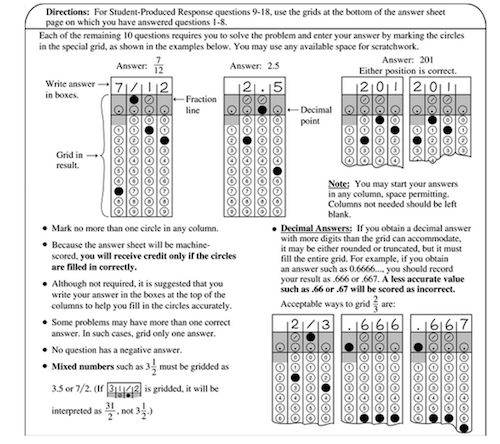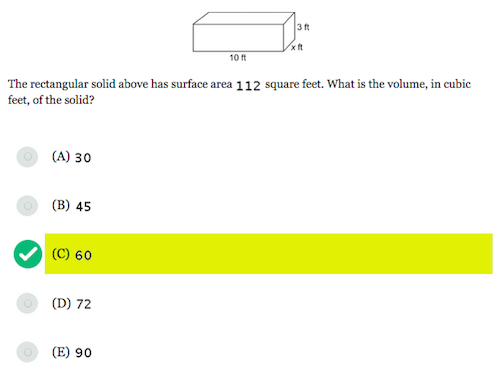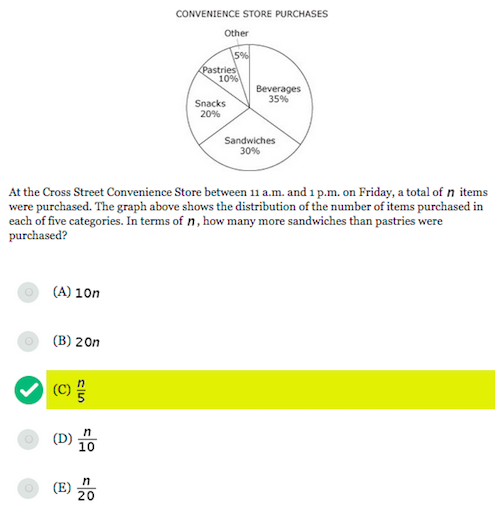
The Mathematics section of the SAT asks students to solve problems with pre-algebra, algebra, geometry, probability, and data analysis from charts and graphs. The SAT does not test advanced math like trigonometry, pre-calculus, or calculus. Students who have taken a high school level algebra class and geometry class likely have sufficient familiarity with the tested concepts to sit for the SAT. Those who have less familiarity with these concepts in their general education will likely benefit from self-teaching with SAT preparation materials.
Note: this article is a series in the PrepScholar 2016 Students' Encyclopedia, a free students' and parents' SAT / ACT guide that provides encyclopedic knowledge. Read all the articles here!
While the SAT Mathematics section does not test advanced concepts or require complex calculations, it challenges students to apply logic and problem-solving skills under strict time limits. SAT math questions may not resemble typical classroom math problems, and they call for careful reading and attention to detail. Questions often require multiple steps to solve, as well as the combined application of concepts from multiple fields. SAT preparation has been shown to lead to score improvements in the math section, as it gives students insight into SAT question types and the testing of relatively basic mathematical concepts in non-traditional ways.
Rather than one long section, SAT Mathematics is divided into three sections. Two of these sections are 25 minutes in length and one is 20 minutes. Altogether, the Mathematics section adds up to a total of 70 minutes. The number of scored Mathematics questions on the SAT remains consistent across tests at 54 questions. Since each SAT has an unmarked experimental section, students may encounter an additional 25-minute math section. If this is the case, then that experimental section will not be factored into the overall Mathematics score.
Of these 54 questions, 44 are multiple choice and 10 are student-produced, commonly known as "grid-in" questions. Students answer the multiple choice questions by filling in the corresponding choices on their answer sheet. Student-produced responses are written in a specially designated section at the bottom of the answer sheet. These grids have spaces for up to four digits, along with the option of adding a decimal point or fraction bar. Unlike for multiple choice questions, there are no point deductions for incorrect responses to grid-in questions.

Besides maintaining the number of mathematics questions on each test at 54, the SAT also remains consistent in the format of each section. One 25-minute section always has 20 multiple choice questions. The other 25-minute section has 8 multiple choice and 10 grid-ins. Finally, the 20 minute section returns to multiple choice with 16 questions.
One strategic approach to the Mathematics section involves the order of difficulty of the questions. Typically questions in the math sections get progressively harder, moving from easy to medium to difficult. Since all questions have equal scoring weight regardless of difficulty level, students may benefit from focusing on the easy and medium questions that they have a greater likelihood of answering correctly.
Students may also be strategic about the number of seconds they spend answering each question, prioritizing questions from which they have the greatest chance of earning points. Top scorers generally leave themselves a larger proportion of time to dedicate to difficult questions. Depending on each test's grading curve, students are allowed only one, if any, incorrect answers to achieve a full score of 800.
The Mathematics questions cover four main areas of content: numbers and operations, algebra and functions, geometry and measurement, and data analysis, statistics, and probability. According to the test developer College Board, the majority of questions cover algebra or geometry.
- Number and operations are tested by 11 to 13 questions.
- Algebra and functions are tested by 19 to 21 questions.
- Geometry and measurement are tested by 14 to 16 questions.
- Data analysis, satistics, and probability are tested by 6 to 7 questions.
College Board further breaks down each of these areas of content into subtopics. Following each list of subtopics is an example of an official SAT sample question.
Number and Operations
- Arithmetic word problems (including percent, ratio, and proportion)
- Properties of integers (even, odd, prime numbers, divisibility, and so forth)
- Rational numbers (numbers that be written as a ratio)
- Sets (union, intersection, elements)
- Counting techniques
- Sequences and series (including exponential growth)
- Elementary number theory (using arithmetic, geometry, or algebra to solve equations with integer or rational solutions)
Sample SAT Question

Algebra and Functions
- Substitution and simplifying algebraic expressions
- Properties of exponents
- Algebraic word problems
- Solutions of linear equations and inequalities
- Systems of equations and inequalities
- Quadratic equations
- Equations of lines
- Absolute value
- Direct and inverse variation
- Concepts of algebraic functions
Sample SAT Question

Geometry and Measurement
- Area and perimeter of a polygon
- Area and circumference of a circle
- Volume of a box, cube, and cylinder
- Pythagorean theorem and special properties of isosceles, equilateral, and right triangles
- Properties of parallel and perpendicular lines
- Coordinate geometry
- Slope
- Similarity
- Transformations
Sample SAT Question

Data Analysis, Statistics, and Probability
- Data interpretation (tables and graphs)
- Descriptive statistics (mean, median, and mode)
- Probability
Sample SAT Question

Each Mathematics section on the SAT begins with a collection of facts, figures, and formulas for students to consult as reference. This reference sheet includes properties of special right triangles, the formulas for finding area, volume, and circumference, and the measure of degrees in a circle and a triangle. While this information is accessible during the test, students are likely to perform better by entering the test with a working knowledge of these facts and formulas.

Students receive the above facts, formulas, and figures at the beginning of each SAT math section.
Students may use calculators on the Mathematics section, though most questions can be solved without the use of a calculator. Most graphing calculators, all scientific calculators, and all four function calculators are allowed. Cell phones, tablets, personal organizers, and calculators with QWERTY keyboards are strictly prohibited. The use of unacceptable technology may result in dismissal from the testing room and score cancellation.
Students who have familiarity with their calculator, especially from within their math classrooms, tend to derive greater benefit from its use. Writing out equations and calculations in the test booklet is also highly recommended for solving problems in the Mathematics section.
Read more from the SAT Encyclopedia!
Further Reading
The 21 Critical Math Formulas You MUST Know
How to Stop Running Out of Time on SAT Math
Calculators on the SAT: Tips from Experts










